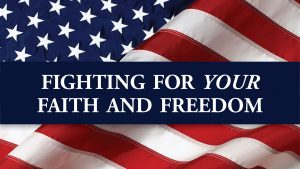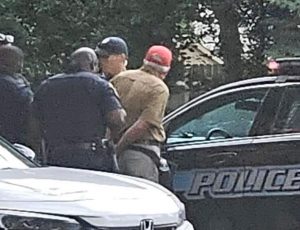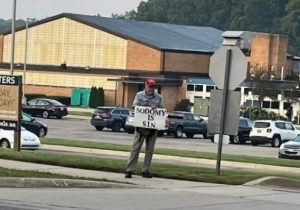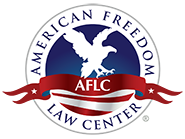 (Ypsilanti, Michigan) – On August 27, 2024, several officers from the City of Ypsilanti, Michigan police department unlawfully detained (handcuffed and placed in a patrol car) our client, Tom Banks, for exercising his fundamental right to freedom of speech.
(Ypsilanti, Michigan) – On August 27, 2024, several officers from the City of Ypsilanti, Michigan police department unlawfully detained (handcuffed and placed in a patrol car) our client, Tom Banks, for exercising his fundamental right to freedom of speech.
See the below photograph, which captured the unlawful actions of the police officers.

On this day, Banks was standing on the public sidewalk outside of Washtenaw International High School and Middle Academy, a public school, holding a sign that stated, “Sodomy is Sin,” in protest of the fact that this school was promoting the LGBT agenda by displaying in its entrance way a large “Happy Pride” banner.
Through the message on his sign, Banks was expressing a viewpoint that is consistent with his Christian beliefs, which are grounded in the Word of God as found in Sacred Scripture. See Leviticus 18:22 (“You shall not lie with a male as with a woman; it is an abomination.”); Romans 1:26-28; 1 Corinthians 6:9-10.
Below is a picture of Banks on the public sidewalk holding his sign.

In fact, on the day prior (August 26), deputies from the Washtenaw County Sheriff’s Department were called in response to a complaint about Banks holding his sign on this public sidewalk outside of the academy. The deputies understood that Banks had a constitutional right to do so, and they affirmed this fact with him. Consequently, unlike the City police officers, the County deputies took no adverse action against Banks (appropriately so) for exercising his First Amendment right to freedom of speech.
On Friday, September 10, 2024, we sent a demand letter to the Chief of Police for the City police department, demanding reassurance that the officers will not interfere with Banks’ constitutional right to protest on a public sidewalk with hand-held signs. We also demanded that the officers return Banks’ sign, which was taken by the police when they handcuffed him.
In our letter to the Chief of police, we set forth the legal basis for our demand:
The U.S. Supreme Court has long held that “all public streets are held in the public trust and are properly considered traditional public fora.” Frisby v. Schultz, 487 U.S. 474, 480-81 (1988) (internal citation omitted). “Wherever the title of streets and parks may rest, they have immemorially been held in trust for the use of the public and, time out of mind, have been used for purposes of assembly, communicating thoughts between citizens, and discussing public questions.” Hague v. CIO, 307 U.S. 496, 515 (1939). And there is no question that Mr. Banks’ sign is a form of expression protected by the First Amendment. See Hill v. Colo., 530 U.S. 703, 714-15 (2000) (“[S]ign displays . . . are protected by the First Amendment.”).
Regardless of the viewpoint you, your officers, or any school officials may have on this issue, Mr. Banks has a constitutional right protected by the First Amendment to display a sign on a public sidewalk even if the sign contains content that is offensive to some or many. Indeed, the First Amendment serves its “high purpose” when it protects off-putting speech. In fact, offensive speech is truly the only speech which requires protection. See Terminiello v. City of Chi., 337 U.S. 1, 4 (1949) (stating that free speech “may indeed best serve its high purpose when it induces a condition of unrest, creates dissatisfaction with conditions as they are, or even stirs people to anger”); see also Forsyth Cnty. v. Nationalist Movement, 505 U.S. 123, 134-35 (1992) (stating that speech cannot be “punished or banned, simply because it might offend a hostile mob”); Cohen v. Cal., 403 U.S. 15, 21 (1971) (holding that viewers who dislike a message have a responsibility to “avoid further bombardment of their sensibilities simply by averting their eyes”).
The possibility that the content of Mr. Banks’ sign might offend passersby has no legal significance and cannot properly be used as a basis for restricting his speech. It is well established that a “[l]istener’s reaction to speech is not a content-neutral basis for regulation.” Forsyth Cnty., 505 U.S. at 134. This is known in First Amendment jurisprudence as a “heckler’s veto.” Lewis v. Wilson, 253 F.3d 1077, 1082 (8th Cir. 2001) (“The First Amendment knows no heckler’s veto.”). And there is no “heckler’s veto” exception because minors may be exposed to the offending message. Ctr. for Bio-Ethical Reform, Inc. v. L.A. Cnty. Sheriff Dep’t, 533 F.3d 780 790 (9th Cir. 2008) (noting that there is no “minors” exception to the heckler’s veto).
Moreover, it is well established that police officers are obligated to protect a controversial speaker and may not silence him to avoid conflict. See, e.g., Edwards v. S.C., 372 U.S. 229 (1963); Bible Believers v. Wayne Cnty., 805 F.3d 228 (6th Cir. 2015) (en banc); see also Ctr. for Bio-Ethical Reform, Inc., 533 F.3d 780.
The law is well established that police officers have an affirmative duty under the First Amendment to protect speakers who engage in controversial speech in a public forum. See, e.g., Bible Believers, 805 F.3d 228 (finding law enforcement liable for suppressing the speech of members of a religious group by siding with those who engaged in violence to suppress the speech that offended them); Dunlap v. City of Chi., 435 F. Supp. 1295, 1298 (N.D. Ill. 1977) (“Section 1983 imposes an affirmative duty upon police officers to protect speakers who are airing opinions which may be unpopular.”); Ctr. for Bio-Ethical Reform, Inc. v. Black, No. 13-CV-581-A, 2017 U.S. Dist. LEXIS 19321, (W.D.N.Y. Feb. 10, 2017) (recognizing the duty of university police officers to protect controversial speech on campus).
As we noted in the letter, should the Chief of Police choose not to provide the requested assurance or return the sign, we will advise Banks of his right to pursue legal action against the City and its officers under 42 U.S.C. § 1983.
